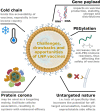The Transformative Potential of Lipid Nanoparticle-Protein Corona for Next-Generation Vaccines and Therapeutics
- PMID: 37782816
- PMCID: PMC10630956
- DOI: 10.1021/acs.molpharmaceut.3c00479
The Transformative Potential of Lipid Nanoparticle-Protein Corona for Next-Generation Vaccines and Therapeutics
Abstract
The integration of the lipid nanoparticle (LNP)-protein corona as a pioneering approach for the development of vaccines against the present and future SARS-CoV-2 variants of concern marks a significant shift in the field. This concept holds great promise, offering a universal platform that can be adaptable to combat future pandemics caused by unknown viruses. Understanding the complex interactions among the protein corona, LNPs, and receptors is crucial for harnessing its potential. This knowledge will allow optimal vaccine formulations and improve their effectiveness. Safety assessments are essential to ensure suitability for human use, compliance with regulatory standards, and rigorous quality control in manufacturing. This transformative workflow requires collaborative efforts, expanding our foundational knowledge and translating advancements from the laboratory to clinical reality. The LNP-protein corona approach represents a paradigmatic shift with far-reaching implications. Its principles and insights can be leveraged beyond specific applications against SARS-CoV-2, enabling a universal platform for addressing viral threats, cancer, and genetic diseases.
Keywords: SARS-CoV-2; lipid nanoparticle; protein corona; vaccination.
Conflict of interest statement
The authors declare no competing financial interest.
Figures


Similar articles
-
The Biomolecular Corona of Lipid Nanoparticles for Gene Therapy.Bioconjug Chem. 2020 Sep 16;31(9):2046-2059. doi: 10.1021/acs.bioconjchem.0c00366. Epub 2020 Aug 31. Bioconjug Chem. 2020. PMID: 32786370 Review.
-
Chemistry of Lipid Nanoparticles for RNA Delivery.Acc Chem Res. 2022 Jan 4;55(1):2-12. doi: 10.1021/acs.accounts.1c00544. Epub 2021 Dec 1. Acc Chem Res. 2022. PMID: 34850635 Review.
-
From influenza to COVID-19: Lipid nanoparticle mRNA vaccines at the frontiers of infectious diseases.Acta Biomater. 2021 Sep 1;131:16-40. doi: 10.1016/j.actbio.2021.06.023. Epub 2021 Jun 18. Acta Biomater. 2021. PMID: 34153512 Free PMC article. Review.
-
Developing Biodegradable Lipid Nanoparticles for Intracellular mRNA Delivery and Genome Editing.Acc Chem Res. 2021 Nov 2;54(21):4001-4011. doi: 10.1021/acs.accounts.1c00500. Epub 2021 Oct 20. Acc Chem Res. 2021. PMID: 34668716 Review.
-
SARS-CoV-2 variants and COVID-19 vaccines: Current challenges and future strategies.Int Rev Immunol. 2023;42(6):393-414. doi: 10.1080/08830185.2022.2079642. Epub 2022 May 28. Int Rev Immunol. 2023. PMID: 35635216 Review.
Cited by
-
mRNA lipid nanoparticle formulation, characterization and evaluation.Nat Protoc. 2025 Mar 11:10.1038/s41596-024-01134-4. doi: 10.1038/s41596-024-01134-4. Online ahead of print. Nat Protoc. 2025. PMID: 40069324 Free PMC article. Review.
-
Lipid Nanoparticle (LNP) Delivery Carrier-Assisted Targeted Controlled Release mRNA Vaccines in Tumor Immunity.Vaccines (Basel). 2024 Feb 12;12(2):186. doi: 10.3390/vaccines12020186. Vaccines (Basel). 2024. PMID: 38400169 Free PMC article. Review.
-
Enhancing Immune Responses against SARS-CoV-2 Variants in Aged Mice with INDUK: A Chimeric DNA Vaccine Encoding the Spike S1-TM Subunits.ACS Omega. 2024 Jul 30;9(32):34624-34635. doi: 10.1021/acsomega.4c03285. eCollection 2024 Aug 13. ACS Omega. 2024. PMID: 39157118 Free PMC article.
-
Central position of histidine in the sequence of designed alternating polarity peptides enhances pH-responsive assembly with DNA.BMC Biotechnol. 2025 Jul 1;25(1):54. doi: 10.1186/s12896-025-00976-4. BMC Biotechnol. 2025. PMID: 40597991 Free PMC article.
-
Albumin Corona Overturns Long-Acting Behaviors of Myristic Acid-Conjugated Quetiapine Nanosuspension.Adv Healthc Mater. 2025 Jun;14(16):e2500851. doi: 10.1002/adhm.202500851. Epub 2025 May 19. Adv Healthc Mater. 2025. PMID: 40384152 Free PMC article.
References
-
- Khurana A.; Allawadhi P.; Khurana I.; Allwadhi S.; Weiskirchen R.; Banothu A. K.; Chhabra D.; Joshi K.; Bharani K. K. Role of nanotechnology behind the success of mRNA vaccines for COVID-19. Nano Today 2021, 38, 101142.10.1016/j.nantod.2021.101142. - DOI - PMC - PubMed
- Thi T. T. H.; Suys E. J.; Lee J. S.; Nguyen D. H.; Park K. D.; Truong N. P. Lipid-based nanoparticles in the clinic and clinical trials: from cancer nanomedicine to COVID-19 vaccines. Vaccines 2021, 9 (4), 359.10.3390/vaccines9040359. - DOI - PMC - PubMed
-
- Akinc A.; Maier M. A.; Manoharan M.; Fitzgerald K.; Jayaraman M.; Barros S.; Ansell S.; Du X.; Hope M. J.; Madden T. D.; et al. The Onpattro story and the clinical translation of nanomedicines containing nucleic acid-based drugs. Nat. Nanotechnol. 2019, 14 (12), 1084–1087. 10.1038/s41565-019-0591-y. - DOI - PubMed
-
- Shores D. L.COVID 19 Patent Wars: mRNA and Lipid Nanoparticle Pioneers Clash over Vaccine Delivery Patents. ABA Landslide Magazine, 2022, 15, (1), , 1–13.
-
- Grewal R.; Nguyen L.; Buchan S. A.; Wilson S. E.; Nasreen S.; Austin P. C.; Brown K. A.; Fell D. B.; Gubbay J. B.; Schwartz K. L.; et al. Effectiveness of mRNA COVID-19 vaccine booster doses against Omicron severe outcomes. Nat. Commun. 2023, 14 (1), 1273.10.1038/s41467-023-36566-1. - DOI - PMC - PubMed
Publication types
MeSH terms
Substances
LinkOut - more resources
Full Text Sources
Medical
Miscellaneous

